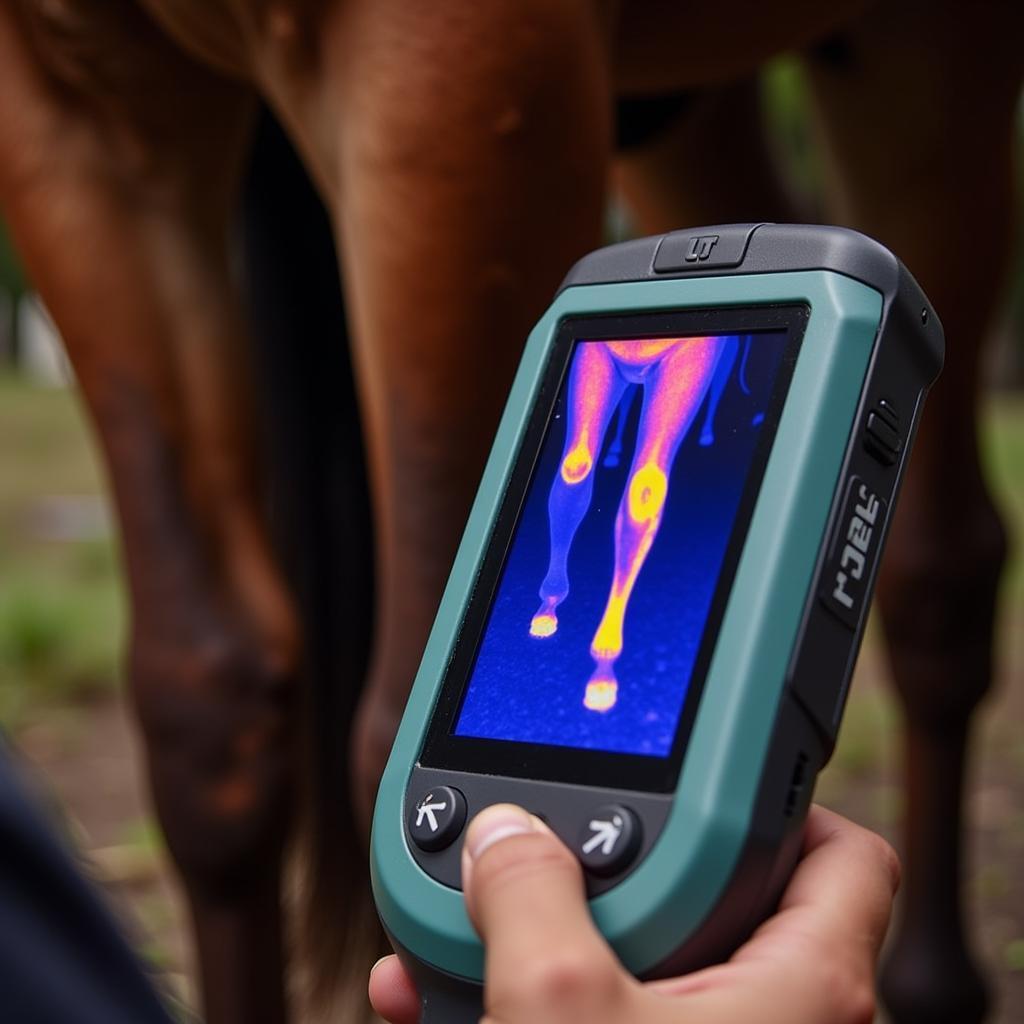Thermal imaging, also known as thermography, is rapidly gaining popularity in the equine world. This non-invasive technology uses a specialized camera to detect infrared radiation, which is then translated into a visual image displaying temperature variations across a horse’s body. But what exactly is thermal imaging, and how can it benefit your equine companion?
 Thermal Imaging Camera for Horses
Thermal Imaging Camera for Horses
Understanding Thermal Imaging for Horses
Every object with a temperature above absolute zero emits infrared radiation. A thermal imaging camera captures this radiation and converts it into a thermogram – a visual map of varying temperatures. In the context of equine health, these temperature differences can be invaluable. They can help identify inflammation, muscle strain, nerve impingement, and other issues that may not be immediately apparent through traditional examination methods.
The Benefits of Thermal Imaging for Horses
Thermal imaging offers a unique perspective on equine health, providing a wealth of information that can aid in diagnosis, treatment, and preventative care.
Early Detection of Issues:
One of the most significant advantages of thermal imaging is its ability to detect subtle changes in temperature that may indicate the early stages of an injury or illness. Early detection often allows for quicker intervention and potentially better outcomes for the horse.
Non-Invasive and Stress-Free:
Unlike many diagnostic procedures that require sedation or confinement, thermal imaging is entirely non-invasive and painless for horses. This minimizes stress for the animal, making it a particularly valuable tool for anxious or sensitive horses.
 Horse Undergoing Thermal Imaging Scan
Horse Undergoing Thermal Imaging Scan
Versatile Applications:
Thermal imaging can be used to assess a wide range of equine health concerns, including:
- Musculoskeletal Issues: Identifying areas of inflammation, muscle strain, tendon and ligament injuries, back pain, and hoof problems.
- Neurological Issues: Detecting nerve compression, inflammation, or damage.
- Circulatory Issues: Assessing blood flow and identifying areas of poor circulation.
- Dental Issues: Locating abscesses or other dental problems.
- Saddle Fit Assessment: Evaluating saddle pressure points and identifying potential areas of discomfort.
Objective and Quantifiable Data:
Thermal imaging provides objective data that can be tracked over time, allowing veterinarians to monitor healing progress, assess the effectiveness of treatment plans, and identify potential problems before they escalate.
How is Thermal Imaging Used in Horses?
The application of thermal imaging is straightforward. A qualified veterinarian or thermographer scans the horse’s body with the camera, capturing images of different regions. These images are then analyzed for abnormal heat patterns, which may indicate an underlying issue.
“Thermal imaging has been a game-changer in my practice,” says Dr. Emily Carter, DVM, an equine veterinarian with over 15 years of experience. “It allows me to see what’s happening beneath the surface, giving me a deeper understanding of my patients’ conditions and enabling me to tailor treatment plans for optimal results.”
 Veterinarian Analyzing Equine Thermal Images
Veterinarian Analyzing Equine Thermal Images
Thermal Imaging for Horses: A Valuable Tool for Equine Wellness
Thermal imaging is a powerful tool that can significantly benefit equine health. Its ability to detect subtle temperature changes, its non-invasive nature, and its diverse applications make it an invaluable asset for veterinarians and horse owners alike. By providing a unique window into the horse’s body, thermal imaging facilitates early detection, accurate diagnosis, and effective treatment, ultimately promoting the well-being of these majestic animals.
FAQs about Thermal Imaging for Horses
Q: How much does equine thermal imaging cost?
A: The cost of equine thermal imaging can vary depending on the location, the veterinarian, and the extent of the scan.
Q: Is thermal imaging safe for horses?
A: Yes, thermal imaging is completely safe for horses. It is non-invasive and does not involve any radiation exposure.
Q: Can thermal imaging be used on all breeds and ages of horses?
A: Yes, thermal imaging can be used on horses of all breeds, ages, and sizes.
Q: What should I expect during a thermal imaging session for my horse?
A: The procedure is typically very quick and stress-free for the horse. The veterinarian will simply scan the horse’s body with the camera, which will be held a short distance away.
Q: Can thermal imaging replace traditional veterinary diagnostics?
A: While thermal imaging is a valuable tool, it is not meant to replace traditional veterinary diagnostics. It is most effective when used in conjunction with other diagnostic methods to provide a comprehensive picture of the horse’s health.
Need More Information?
If you’re interested in learning more about thermal imaging for your horse, please don’t hesitate to contact us. Our team of experts at Justus Horses USA is dedicated to providing you with the information and resources you need to ensure the well-being of your equine companion. Call us at 0772127271, email us at [email protected], or visit us at QGM2+WX2, Vị Trung, Vị Thuỷ, Hậu Giang, Vietnam. We’re available 24/7 to assist you.